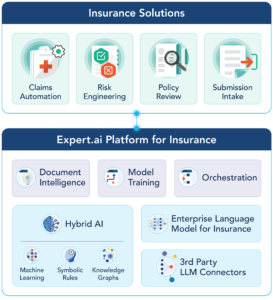Given the unprecedented volumes of unstructured data that companies have access to, technologies like text analytics are undoubtedly having a moment. Being able to extract valuable insights from business documents like contracts, claims, emails, presentations, customer interactions, blog posts, comments and news streams to name a few is absolutely crucial for competitive advantage. By leveraging this technology, organizations can create more value to be competitive in their market using the right information at the right time to support decision making.
What is Text Analytics Important?
Although the text analytics market is quite mature, there are a lot of misconceptions about what it is and how companies can use it. To many business users, it is a kind of “magic box” where unstructured text goes in, and structured data magically comes out. Not exactly.
Text analytics is essentially about making human information (text, documents, language) understandable by computers and a way to discover value in text.
According to Quadrant Knowledge Solutions, “Text analytics involves processing semi-structured and unstructured documents to derive meaningful data for analysis promoting relevant automation and critical business insights.”
Quadrant Knowledge Solutions recently issued its 2023 SPARK Matrix™ for Text Analytics Platforms, where expert.ai has been recognized as a Technology Leader.
With this technology, you can analyze any type of unstructured text or semi-structured data, extracting high-quality and relevant information that can drive further analysis and strategic decision-making.
How this happens depends on the underlying approach.
Why Text Analytics Can Make or Break Your NLP Investment
While natural language processing (NLP) refers to the technologies that allow computers to understand human languages, text analytics is used in NLP to examine the structure and meaning of written content. Together, NLP and text analytics break down language data so components can be analyzed and understood. The technology is crucial to NLP applications, providing a robust, accurate understanding of language data at scale.
Here, the key word is “understanding.” As a recent Forrester Wave reported: “Text analytics is table stakes, but not all of its capabilities are equal.” Errors in language understanding can wreak havoc on text analytics applications, and the accuracy of the NLP at work depends on the approach that underlies your application.
Traditional technologies that deal with the types of natural language information we mentioned above merely manage lists of keywords and patterns without understanding the meaning of the terms. This makes it more difficult to have confidence that you’re leveraging your information to the fullest.
Instead, technologies that understand the human aspects of text ensure that you can capture the meaning and context being conveyed in information with much greater accuracy. We’re talking about natural language understanding (NLU) technologies that, together with NLP, understand the correct meaning of words and expressions out of the box and identify the relationships between concepts in the text. This allows you to leverage information contained in customer service interactions, contracts, and intake forms, risk assessment reports, and emails with greater confidence and effectiveness.
How Does Text Analytics Work
Text analytics refers to techniques that are used to process large volumes of unstructured text in order to derive insights, patterns and understanding. These techniques can include determining and classifying the subjects of texts, summarizing texts, extracting key entities from texts and identifying the tone or sentiment of texts (sentiment analysis).
When text analytics and NLP are used together they can provide contextual understanding of unstructured text data. This kind of data is found in documents, emails and any of the many ways that we use to communicate through language and text. In other words, text analytics and NLP work on the non-numerical, non-structured and semi-structured data that makes up the majority of enterprise information.
The type of processes and activities where this technology is useful are those that rely on a significant amount of information, making manual analysis within a reasonable amount of time impossible. Additionally, it is beneficial in processes and activities where there is a high risk of human error or bias. Insurance claims, contract management, know your customer analysis (customer surveys and customer experience), risk management, information discovery: these are just a few examples (infographic below.)
Text Analytics Use Cases
Let’s look at a practical application of text analytics in a language-intensive and high-data volume industries: Pharma & Life Sciences and Insurance.
Pharma and Life Sciences
Manually searching multiple sources, such as clinical trial databases or medical and scientific publications, requires a significant amount of time and resources. Whether you’re a pharmaceutical company bringing a new drug to market or a regulatory agency evaluating the compliance of a new product, scientists and knowledge workers must sort through huge volumes of documents to retrieve the proper documentation.
At expert.ai, we recently launched our new Platform for Life Sciences that utilizes automatic industry language models and AI-based natural language capabilities to transform health and scientific data into insight that can support decision making for scientific claim validation, drug discovery, clinical trial insights, regulatory report analysis, and more.

This ensures the highest level of precision and recall in search, enabling Pharma & Life Sciences teams to respond quickly to FDA requests as well as to capture more value to drive enhanced efficiency and innovation while ensuring security, privacy, and accuracy.
Insurance
As digital transformation processes continue driving innovation for the insurance market, higher levels of efficiency and the ability to reduce costs while maintaining a focus on the quality of the offer to meet customer demands are core elements to create value and maintain a competitive advantage. The most relevant insurance processes usually require handling multiple sources of unstructured language data. Here, the ability to accurately understand text at scale accelerates the automation of complex, information-rich processes. By confirming our commitment to help insurers improve their throughput and optimize the cost of operations for language-intensive workflows, we recently launched the expert.ai Platform for Insurance, which is now available to our customers and partners.

Risk engineers, underwriters and claims handlers can rely on our platform for Insurance to use enterprise insurance language models and leverage text analytics and NLP to identify and extract data needed to prioritize submission or claims. This way, they can intelligently automate their processes, freeing up time to manage more complex tasks resulting in better customers service.
So, text analytics may not be a magic box, but a business partner? Definitely. Download the the expert.ai Text Analytics Buyer’s Guide to learn more.



